As quick as a Western Port tide, Santa came and went, so have the snapper with anglers now heavily focused on Western Port’s other most highly prized species. Although it is time for ourselves and our children to get ready to go back to school, February is a great time to be on the water.
The offshore scene in Bass Strait has been quite productive, although some anglers have been doing it tough on occasion. There has been plenty of offshore action with some solid mako sharks caught right out the front of both the western and eastern entrances.
For consistency, depths ranging 50-70m has seen a lot of shark action off Cape Schank. This area always produces a lot of fish each season and once again, has done so. Regular Tackle World customer Kristian Perez and his son Zach fished out wide off Cape Schank and managed a cracking mako that pulled the scales down to 82.7kg.
Brendan Wing from YouFish TV and brothers Dave and Brad Standing headed out for a shark session one fine day and came up trumps with a 105kg beast landed. The boys had a great day and proved that there are some thumping mako’s within Bass Strait’s waters.
Although not a common target around the Phillip Island coastline these days, thresher sharks are everywhere. Customer Craig Purcell had an awesome offshore session at the Nobbies catching three thresher sharks with the largest estimated at 50kg and the smallest around 20kg.
The reef, which runs from Kilcunda back to the Eastern entrance, has been productive for a wide range of species. Flathead, snapper and salmon have been welcomed catches but it is the occasional catch of kingfish that has been most outstanding. One angler by the name of George had been trolling for pike and snook in 15m of water just off Black Head when he managed a kingfish around the 8kg mark. George reported that when landing he could see more under the boat but they took off quickly once landing his fish.
Other reports of kingfish were reported around the bommie just out from Cape Woolamai but most were small fish in the 50-65cm range. These were caught trolling small occy skirts for the striped tuna, which haven’t been a reported capture just yet.
The Flinders Bank has been fishing exceptionally well for tiger flathead. Fishing the run-out tide and drifting baits over the ledge has seen many good models caught. Most are good sized with a typical paternoster rig working well.
Those looking for some real line screaming action inside the Port should hold off until the lead up to the full moon. February and March full moon cycles tend to be when the larger gummy sharks enter the Port. Remember, many of these bigger models are females looking for somewhere to have their pups, catch and release is good practise and will ensure the species doesn’t become over fished.
Larger gummy sharks do prefer a faster running current, which is why the Western Entrance is one of the more productive locations to fish for them.
Running sinker rigs made up from 80lb trace is about the standard as encounters of seven-gill sharks are common, 80lb might prevent a bite off if used in conjunction with a 6/0 or 8/0 size circle hook.
Cat Bay has been a productive location yet the ocean swells have dictated whether or not anglers can get to it. When the weather has been nice, Cat Bay has certainly turned it on in a big way.
This area, set just inside the Western Entrance on the Phillip Island is a haven for big whiting, silver trevally, pinkie snapper, gummy sharks and school sharks.
In close over the sand patches, whiting are abundant but it can take a little time to locate them. Berley will help immensely in this situation. If you push further out into 10m of water and fish the last of the run-out tide, you’re always a good chance of some solid gummy sharks. Be prepared though, some other big bities can often snaffle your offerings.
If it is whiting you seek, then look no further than the Tortoise Head Bank. Although a tricky location to find whiting, the sand patches are quite visible up on the shallows. This location has been fishing its best on the last two hours of the run-in tides.
In saying that, if you push back into 5m of water during the first of the run-out, you can encounter some larger models. This bank will fish well for the next few months but the water begins to cool further towards March, so head back to the middle spit.
The southern end of the middle rarely gets a lot of angler attention but yields a great catch of whiting at this time of year. Anglers fishing for whiting do tend to fish shallow but if you want larger whiting set your anchor in 10-14m and fish in the same manner. Heavier sinkers up to 6oz will be required but the average whiting caught will be around 40cm.
Berley is required to bring them to your location but there is not need to go to the extreme. Keep things simple with just a block of mashed up pilchards in the pot.
Rhyll is still producing some nice snapper on the ebb tides with most fish coming from The Corals. This location is particularly popular with holidaymakers and continues to produce snapper right through until late March. The only downfall to fishing the Feb/March period is that the elephants also move into this area driving out the snapper. Still, for those keen on catching an elephant, this is the location to be fishing.
Over the next few weeks the fishing will continue to get better and better and with plenty of species on offer, it is time to keep the lines wet rather than having them gathering dust.
Reads: 5307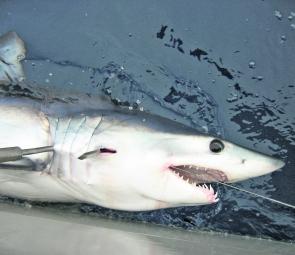
If it is a mako shark you seek, look no further than Cape Schank.
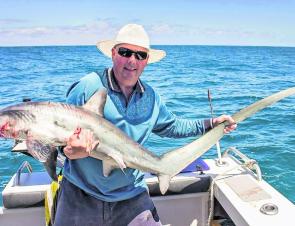
Craig Purcell displays a decent thresher shark caught from the Nobbies.

Zach is pretty chuffed with his 82.7kg mako.
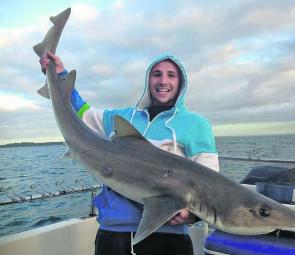
Tristian Cincotta displays his personal best gummy shark caught recently.
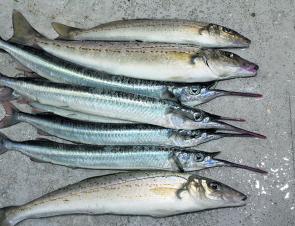
Although there are plenty of big whiting about, there are also some monster garfish.
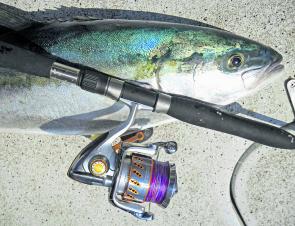
Every Victorian anglers dream is to catch a kingfish and there have been some nice models about.




